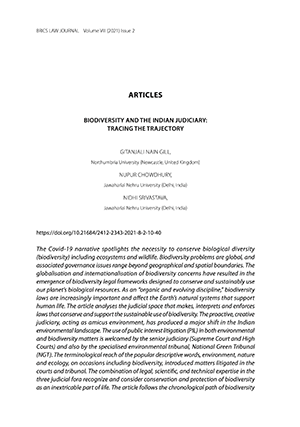Biodiversity and the Indian Judiciary: Tracing the Trajectory
The Covid-19 narrative spotlights the necessity to conserve biological diversity (biodiversity) including ecosystems and wildlife. Biodiversity problems are global, and associated governance issues range beyond geographical and spatial boundaries. The globalization and internationalization of biodiversity concerns have resulted in the emergence of biodiversity legal frameworks designed to conserve and sustainably use our planet’s biological resources. As an “organic and evolving discipline,” biodiversity laws are increasingly important and affect the Earth’s natural systems that support human life. The article analyses the judicial space that makes, interprets and enforces laws that conserve and support the sustainable use of biodiversity. The proactive, creative judiciary, acting as amicus environment, has produced a major shift in the Indian environmental landscape. The use of public interest litigation (PIL) in both environmental and biodiversity matters is welcomed by the senior judiciary (Supreme Court and High Courts) and also by the specialized environmental tribunal, National Green Tribunal. The terminological reach of the popular descriptive words, environment, nature and ecology, on occasions including biodiversity, introduced matters litigated in the courts and tribunal. The combination of legal, scientific and technical expertise in the three judicial fora recognize and consider conservation and protection of biodiversity as an inextricable part of life. The article follows the chronological path of biodiversity litigation, i.e. pre 1992–2002; then 2002–2010 and finally 2010–2020 and examines significant aspects of the three decades of biodiversity litigation.
